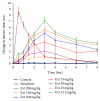Evaluation of Analgesic Activity of Papaver libanoticum Extract in Mice: Involvement of Opioids Receptors
- PMID: 28280516
- PMCID: PMC5320386
- DOI: 10.1155/2017/8935085
Evaluation of Analgesic Activity of Papaver libanoticum Extract in Mice: Involvement of Opioids Receptors
Abstract
Papaver libanoticum is an endemic plant to Lebanese region (family Papaveraceae) that has not been investigated before. The present study aimed to explore the analgesic activity of dried ethanolic extract of Papaver libanoticum (PLE) using tail flick, hot plate, and acetic acid induced writhing models in mice. The involvement of opioid receptors in the analgesic mechanism was investigated using naloxone antagonism. Results demonstrated that PLE exhibited a potent dose dependent analgesic activity in all tested models for analgesia. The analgesic effect involved activation of opioid receptors in the central nervous system, where both spinal and supraspinal components might be involved. The time course for analgesia revealed maximum activity after three hours in both tail flick and hot plate methods, which was prolonged to 24 hours. Metabolites of PLE could be responsible for activation of opioid receptors. The EC50 of PLE was 79 and 50 mg/kg in tail flick and hot plate tests, respectively. The total coverage of analgesia by PLE was double that of morphine in both tests. In conclusion, PLE proved to have opioid agonistic activity with a novel feature of slow and prolonged effect. The present study could add a potential tool in the armaments of opioid drugs as a natural potent analgesic and for treatment of opioid withdrawal syndrome.
Conflict of interest statement
The authors declare that there is no conflict of interests regarding the publication of this paper.
Figures








Similar articles
-
Spinal and Supraspinal sites for morphine and nefopam analgesia in the mouse.Eur J Pharmacol. 1981 Sep 11;74(2-3):135-40. doi: 10.1016/0014-2999(81)90523-9. Eur J Pharmacol. 1981. PMID: 6276187
-
Assessment of the analgesic effect of centhaquin in mouse tail flick and hot-plate tests.Pharmacology. 2011;88(5-6):233-41. doi: 10.1159/000331880. Epub 2011 Oct 12. Pharmacology. 2011. PMID: 21997570
-
A long-form alpha-neurotoxin from cobra venom produces potent opioid-independent analgesia.Acta Pharmacol Sin. 2006 Apr;27(4):402-8. doi: 10.1111/j.1745-7254.2006.00293.x. Acta Pharmacol Sin. 2006. PMID: 16539838
-
Opioid and nonopioid components independently contribute to the mechanism of action of tramadol, an 'atypical' opioid analgesic.J Pharmacol Exp Ther. 1992 Jan;260(1):275-85. J Pharmacol Exp Ther. 1992. PMID: 1309873
-
Differential mechanisms mediating beta-endorphin- and morphine-induced analgesia in mice.Eur J Pharmacol. 1989 Sep 1;168(1):61-70. doi: 10.1016/0014-2999(89)90633-x. Eur J Pharmacol. 1989. PMID: 2531093
Cited by
-
A Comprehensive Review on Chemical and Pharmacological Potential of Viola betonicifolia: A Plant with Multiple Benefits.Molecules. 2019 Aug 29;24(17):3138. doi: 10.3390/molecules24173138. Molecules. 2019. PMID: 31470508 Free PMC article. Review.
-
Unveiling the pharmacological potential of Coelogyne suaveolens: An investigation of its diverse pharmacological activities by in vivo and computational studies.Food Sci Nutr. 2023 Dec 7;12(3):1749-1767. doi: 10.1002/fsn3.3867. eCollection 2024 Mar. Food Sci Nutr. 2023. PMID: 38455216 Free PMC article.
-
Conifers Phytochemicals: A Valuable Forest with Therapeutic Potential.Molecules. 2021 May 18;26(10):3005. doi: 10.3390/molecules26103005. Molecules. 2021. PMID: 34070179 Free PMC article. Review.
-
Analgesic and Antipyretic Activities of Ethyl Acetate Fraction Tablet of Andrographis paniculata in Animal Models.Evid Based Complement Alternat Med. 2021 Mar 8;2021:8848797. doi: 10.1155/2021/8848797. eCollection 2021. Evid Based Complement Alternat Med. 2021. PMID: 33747115 Free PMC article.
-
Isolation of methyl caffeate and flacourtin from Flacourtia jangomas with comprehensive in-vitro and in-vivo pharmacological evaluation.Heliyon. 2024 Nov 16;10(23):e40445. doi: 10.1016/j.heliyon.2024.e40445. eCollection 2024 Dec 15. Heliyon. 2024. PMID: 39654712 Free PMC article.
References
-
- Pires J. M., Mendes F. R., Negri G., Duarte-Almeida J. M., Carlini E. A. Antinociceptive peripheral effect of Achillea millefolium L. and Artemisia vulgaris L.: both plants known Popularly by brand names of analgesic drugs. Phytotherapy Research. 2009;23(2):212–219. doi: 10.1002/ptr.2589. - DOI - PubMed
-
- Hanson G. R., Venturelli P. J., Fleckenstein A. E. Drugs and Society. 10th. Boston, Mass, USA: Jones and Bartlett; 2009.
LinkOut - more resources
Full Text Sources
Other Literature Sources

